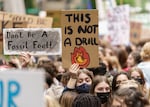
FILE - Thousands of youth climate activists and supporters march through downtown Portland, May 20, 2022. The Portland Clean Energy Fund is close to investing tens of millions of dollars in area school districts for climate projects.
Kristyna Wentz-Graff / OPB
The Portland Clean Energy Fund is one step closer in investing tens of millions of dollars in seven school districts within Portland city limits to boost renewable energy upgrades and climate action over the next five years.
Portland city commissioners heard from staff of the Portland Clean Energy Fund, or PCEF, on Thursday about an initiative that could reduce greenhouse gas emissions from a handful of public schools in Portland. The money would also increase climate action through student-led projects.
The Climate Friendly Public Schools plan would invest $50 million toward seven school districts. The money would fund projects like energy efficient retrofits for older buildings, including air conditioning, heat and improved air ventilation. The money would also go toward installing solar panels and energy efficient appliances, purchasing electric school buses, and increasing tree canopy in schoolyards.
City Commissioner Carmen Rubio oversees the Bureau of Planning and Sustainability, which manages the fund. She said investing in schools will help children as human-caused climate change becomes more extreme.
“It’s critical to ensure that our schools are healthy places for our kids to learn free of mold, exposure to extreme heat, wildfire, smoke, and so many more issues created or exacerbated by the climate crisis,” she said. “With the schools controlling such significant assets across our community, our investment presents a wonderful opportunity to make impactful emissions reductions meaningfully, reduce utility costs and serve those who will inherit this place after us.”
Schools must meet two qualifications to apply for funds: They must be located within Portland city limits and offer free and reduced lunch. PCEF used a state Department of Education formula that included a number of factors, including enrollment of Black, Indigenous and students of color, in determining allocations to each district eligible for funding.
The plan stems from PCEF’s five-year, $750 million Climate Investment Plan, which was approved last September.
The voter-passed Portland Clean Energy Fund uses a tax on retail sales in the city to generate money, with a particular aim of addressing effects of climate change in communities that have historically been marginalized or underserved.
The proposed initiative could ultimately reduce carbon dioxide emissions by up to 24,000 metric tons, according to PCEF staff. That’s equivalent to the annual emissions of more than 5,700 gas-powered vehicles.
The seven school districts include:
- Portland Public Schools — $19,930,833
- David Douglas — $12,036,146
- Parkrose — $5,729,479
- Centennial — $4,692,500
- Reynolds — $4,190,313
- Multnomah ESD — $3,420,729
- Riverdale — $75,000
Combined, all seven Portland school districts have more than 70,000 enrolled students and more than 100 K-12 schools.
Wendy Koelfgen, the fund’s commercial and multifamily lead, said each school district will have to pitch projects they want to spend money on, including student-led initiatives.
“Each school district will propose the climate projects or project that will best serve their districts,” she said. “Projects will be reviewed and approved by PCEF staff to ensure funding is going toward eligible expenses that reduce greenhouse gas emissions and improve resiliency.”
Each school will have two years to provide PCEF with project proposals, including a workforce and contractor equity plan, budget and timeline.
During public testimony, Lincoln High School senior and organizer with the Portland Youth Climate Strike Chloe Gilmore said older buildings that lack proper ventilation and insulation exposed students to air pollution and extreme temperatures. Because of that, she said, the city needs to prioritize schools to ensure they are clean, safe and equitable.
Gilmore recalled personal experiences with extreme weather events and having to attend school.
“I remember dripping in sweat because of increasingly hot temperatures during a heat wave in my sophomore year,” she said. “It was impossible to learn and many of my peers struggled with test performance on these days. These conditions will only worsen in the face of the climate crisis.”
Others who spoke at this week’s City Council meeting supported the initiative, while praising the original intent of the Portland Clean Energy Fund and calling on the commissioners to stick with voter intentions for the fund.
Last year, Commissioner Rubio proposed $540 million in additional investments from PCEF go toward city bureaus’ existing climate-related projects. The proposal came after city economists conducted an updated forecast that showed the fund would generate tens of millions of dollars in additional revenue than anticipated.
In February, the PCEF committee voted unanimously to allocate $282 million to city bureaus as city budget deadlines were due.
The increase in funds also prompted two city commissioners to suggest other uses, including paying for the Portland Street Response program and covering the entire Fire Bureau’s $11 million budget gap — causes some saw as divorced from PCEF’s stated goals.
City Council is scheduled for a vote on the Climate Friendly Public Schools initiative on May 8.
Editor’s note: This story has been updated to clarify the role that enrollment of Black, Indigenous and students of color plays in how funds are distributed to schools. It was one of many factors considered in a formula allocating Clean Energy Fund money to school districts, but not for the qualifications of the Climate Friendly Public Schools.



